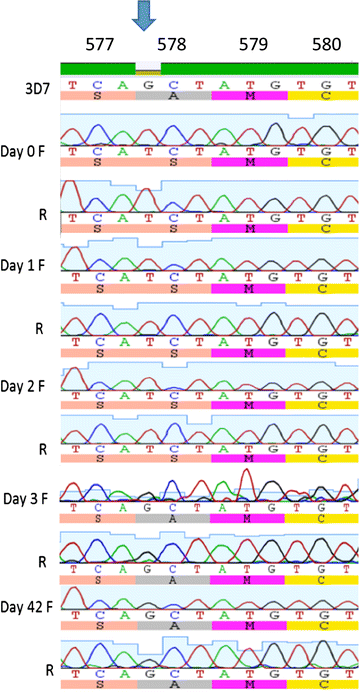Lack of K13 mutations in Plasmodium falciparum persisting after artemisinin combination therapy treatment of Kenyan children
- PMID: 26801909
- PMCID: PMC4722670
- DOI: 10.1186/s12936-016-1095-y
Lack of K13 mutations in Plasmodium falciparum persisting after artemisinin combination therapy treatment of Kenyan children
Abstract
Background: Studies in Southeast Asia reported a strong relationship between polymorphisms at the propeller domain of the Kelch 13 (K13) protein encoded by the Plasmodium falciparum k13 (pfk13) gene and delayed parasite clearance after artemisinin treatment. In Africa, P. falciparum remains susceptible and combination therapy regimens which include an artemisinin component display good efficacy. Using quantitative real-time PCR (qPCR), sub-microscopic persistence of P. falciparum has previously been reported in one-third of children treated with artemisinin combination therapy (ACT) in western Kenya. In this study, further investigation was made to evaluate whether these sub-microscopic residual parasites also harbour mutations at the propeller region of pfk13 and whether the mutations, if any, affect treatment outcome.
Methods: The pfk13 propeller domain was genotyped in DNA samples obtained in 2009 from Kenyan children treated with artemether-lumefantrine (AL) and dihydroartemisinin-piperaquine (DP). Paired samples at pre-treatment (day 0) and day of treatment failure (day 28 or 42) for 32 patients with documented recurrent parasitaemia were available for genotyping. Additional day 3 DNA samples were available for 10 patients.
Results: No mutation associated with artemisinin resistance in Southeast Asia was observed. Only one DP-treated patient harboured a non-synonymous mutation at codon 578 (A578S) of pfk13-propeller gene in the day 0 sample, but this allele was replaced by the wild-type (A578) form on day 3 and on the day of recurrent parasitaemia. The mutation at amino acid codon 578 showed no association with any phenotype. Polymorphisms in pfk13 were not responsible for parasite persistence and gametocyte carriage in the children treated with ACT.
Conclusion: This study contributes to the ongoing surveillance of suspected artemisinin resistance parasites in Africa by providing baseline prevalence of k13-propeller mutations in western Kenya with samples collected from a longitudinal study. Clinical Trials Registration NCT00868465.
Figures

Similar articles
-
Assessment of molecular markers of anti-malarial drug resistance among children participating in a therapeutic efficacy study in western Kenya.Malar J. 2020 Aug 14;19(1):291. doi: 10.1186/s12936-020-03358-7. Malar J. 2020. PMID: 32795367 Free PMC article.
-
Absence of association between polymorphisms in the K13 gene and the presence of Plasmodium falciparum parasites at day 3 after treatment with artemisinin derivatives in Senegal.Int J Antimicrob Agents. 2017 Jun;49(6):754-756. doi: 10.1016/j.ijantimicag.2017.01.032. Epub 2017 Apr 24. Int J Antimicrob Agents. 2017. PMID: 28450175
-
Day 3 parasitemia and Plasmodium falciparum Kelch 13 mutations among uncomplicated malaria patients treated with artemether-lumefantrine in Adjumani district, Uganda.PLoS One. 2024 Jun 5;19(6):e0305064. doi: 10.1371/journal.pone.0305064. eCollection 2024. PLoS One. 2024. PMID: 38837973 Free PMC article.
-
Emerging Plasmodium falciparum K13 gene mutation to artemisinin-based combination therapies and partner drugs among malaria-infected population in sub-Saharan Africa.Parasites Hosts Dis. 2025 May;63(2):109-122. doi: 10.3347/PHD.24053. Epub 2025 May 26. Parasites Hosts Dis. 2025. PMID: 40452273 Free PMC article. Review.
-
A review of the frequencies of Plasmodium falciparum Kelch 13 artemisinin resistance mutations in Africa.Int J Parasitol Drugs Drug Resist. 2021 Aug;16:155-161. doi: 10.1016/j.ijpddr.2021.06.001. Epub 2021 Jun 10. Int J Parasitol Drugs Drug Resist. 2021. PMID: 34146993 Free PMC article. Review.
Cited by
-
Lack of artemisinin resistance in Plasmodium falciparum in northwest Benin after 10 years of use of artemisinin-based combination therapy.Parasite. 2016;23:28. doi: 10.1051/parasite/2016028. Epub 2016 Jul 21. Parasite. 2016. PMID: 27443837 Free PMC article.
-
Prevalence of molecular markers of sulfadoxine-pyrimethamine and artemisinin resistance in Plasmodium falciparum from Pakistan.Malar J. 2018 Dec 17;17(1):471. doi: 10.1186/s12936-018-2620-y. Malar J. 2018. PMID: 30558587 Free PMC article.
-
Absence of in vivo selection for K13 mutations after artemether-lumefantrine treatment in Uganda.Malar J. 2017 Jan 9;16(1):23. doi: 10.1186/s12936-016-1663-1. Malar J. 2017. PMID: 28068997 Free PMC article.
-
High throughput resistance profiling of Plasmodium falciparum infections based on custom dual indexing and Illumina next generation sequencing-technology.Sci Rep. 2017 May 25;7(1):2398. doi: 10.1038/s41598-017-02724-x. Sci Rep. 2017. PMID: 28546554 Free PMC article.
-
Artemisinin Action and Resistance in Plasmodium falciparum.Trends Parasitol. 2016 Sep;32(9):682-696. doi: 10.1016/j.pt.2016.05.010. Epub 2016 Jun 9. Trends Parasitol. 2016. PMID: 27289273 Free PMC article. Review.
References
-
- Witkowski B, Amaratunga C, Khim N, Sreng S, Chim P, Kim S, et al. Novel phenotypic assays for the detection of artemisinin-resistant Plasmodium falciparum malaria in Cambodia: in vitro and ex vivo drug-response studies. Lancet Infect Dis. 2013;13:1043–1049. doi: 10.1016/S1473-3099(13)70252-4. - DOI - PMC - PubMed
-
- WHO. Status report on artemisinin resistance. 2014. WHO/HTM/GMP/2014.9. http://www.who.int/malaria/publications/atoz/status_rep_artemisinin_resi.... Accessed 10 March 2015.
Publication types
MeSH terms
Substances
Associated data
LinkOut - more resources
Full Text Sources
Other Literature Sources
Medical
Research Materials

